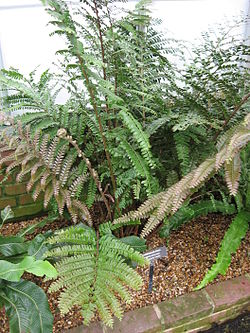| Didymochlaena | |
|---|---|
 | |
| Didymochlaena truncatula | |
| Scientific classification | |
| Kingdom: | Plantae |
| Clade: | Tracheophytes |
| Division: | Polypodiophyta |
| Class: | Polypodiopsida |
| Order: | Polypodiales |
| Suborder: | Polypodiineae |
| Family: | Didymochlaenaceae Ching ex Li Bing Zhang & Liang Zhang |
| Genus: | Didymochlaena Desv. |
| Type species | |
| Didymochlaena sinuosa Desv. | |
| Species | |
| Synonyms [1] | |
Didymochlaena is a genus of ferns. In the Pteridophyte Phylogeny Group classification of 2016 (PPG I), it is the only genus in the family Didymochlaenaceae. [2] Alternatively, the family may be placed in a very broadly defined family Polypodiaceae sensu lato as the subfamily Didymochlaenoideae. [3]